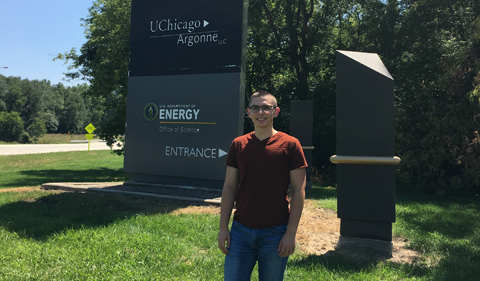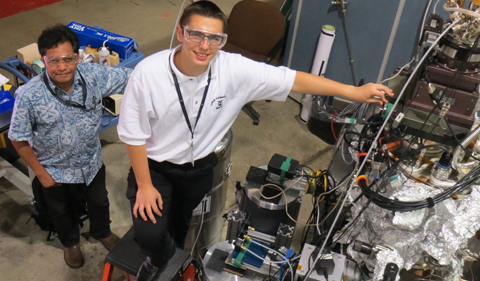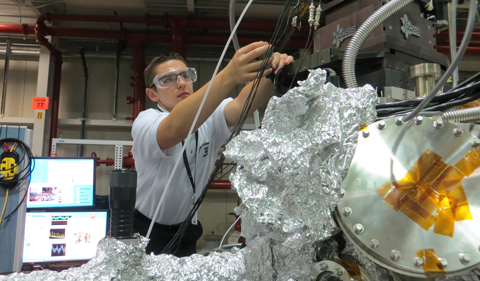
Ryan Tumbleson at the entrance to Argonne National Lab
By Ryan Tumbleson ’20
HTC Engineering Physics and Electrical Engineering studying near Chicago
It’s mid-July and I’m halfway through my summer internship with Dr. Saw-Wai Hla at Argonne National Laboratory, located just outside Chicago. Dr. Hla has a joint appointment—he is a professor in Physics & Astronomy at Ohio University, as well as the Group Leader in the Quantum & Energy Materials section at Argonne. He’s a nanotechnology expert in single-atom and single-molecule manipulation and member of OHIO’s Nanoscale & Quantum Phenomena Institute.
I’m learning about Dr. Hla’s nanoscience research as well as some quantum mechanics behind the science. My internship enables me to see where theoretical physics informs real world applications.
Argonne consists of multiple different sectors and departments. I work at the Center for Nanoscale Materials (CNM) where we collaborate with researchers at the Advanced Photon Source (APS) facility. The CNM and the APS buildings are connected and APS is where the synchrotron, or “beamline” is located. The synchroton is a type of particle accelerator. If you want to know more about a synchroton, there’s a pretty good description on Wikipedia.
I’m learning how to use specialized microscopes including a scanning tunneling microscope (STM). It’s an instrument for imaging surfaces at the atomic level. It was invented in 1981 by Ged Binnig and Heinrich Rohrer in Switzerland. The STM I’m working on will be used in studying the beamline in an experiment later this summer.
When the beamline is switched on, it will be running for two weeks nonstop and we will be working 24/7. We’ll then need to take a few weeks to make adjustments before running it for another full week. There are many kinds of research going on when the beamline is active. Our group will be studying the electrical properties of the materials in the beamline itself.
One of the amazing unique research tools we use is a system called an SXSTM, or Synchrotron X-Ray Scanning Tunneling Microscope. This is the first instrument of its kind in the world and it can probe atomic scale chemical, elemental and magnetic structures simultaneously.

While Dr. Hla observes, I’m on a ladder in the Advanced Photon Source facility at Argonne with my fingers on the xyz manipulator stage that houses LT-UHV-SXSTM. Photo: Argonne Nat’l Lab
When Dr. Hla is at Argonne, I typically meet with him about once a day or every other day depending on his schedule. While in the lab, there is at least one other person present to supervise me while I use the STM. Most of my training has come from Dr. Yuan Zhang, a postdoctoral researcher, who received her Ph.D. from OHIO under the direction of Dr. Hla.
Since I haven’t been formally taught quantum mechanics yet, I’m learning basic concepts needed to understand the materials process and how to use the equipment, especially the STM. Dr. Hla and I cover the material almost daily, so I’m learning at an accelerated pace.
The combination of theory, instruction, and opportunity to use the equipment provides the best kind of internship learning experience.

Standing on a ladder in the Advanced Photo Source (APS) facility, I adjust an ‘xyz’ movement stage of the low temperature ultrahigh vacuum synchrotron X-ray scanning tunneling microscope (LT-UHV-SX-STM). This experiment is to determine magnetic moment of ultra-thin cobalt film. The LT-UHV-SXSTM has been developed jointly by the Center for Nanoscale Materials, the APS, and OHIO’s Physics & Astronomy (Hla group). Photo: Argonne National Lab
Next Week – Tumbleson: Argonne Nat’l Lab Interns Tour Chicago



















Comments